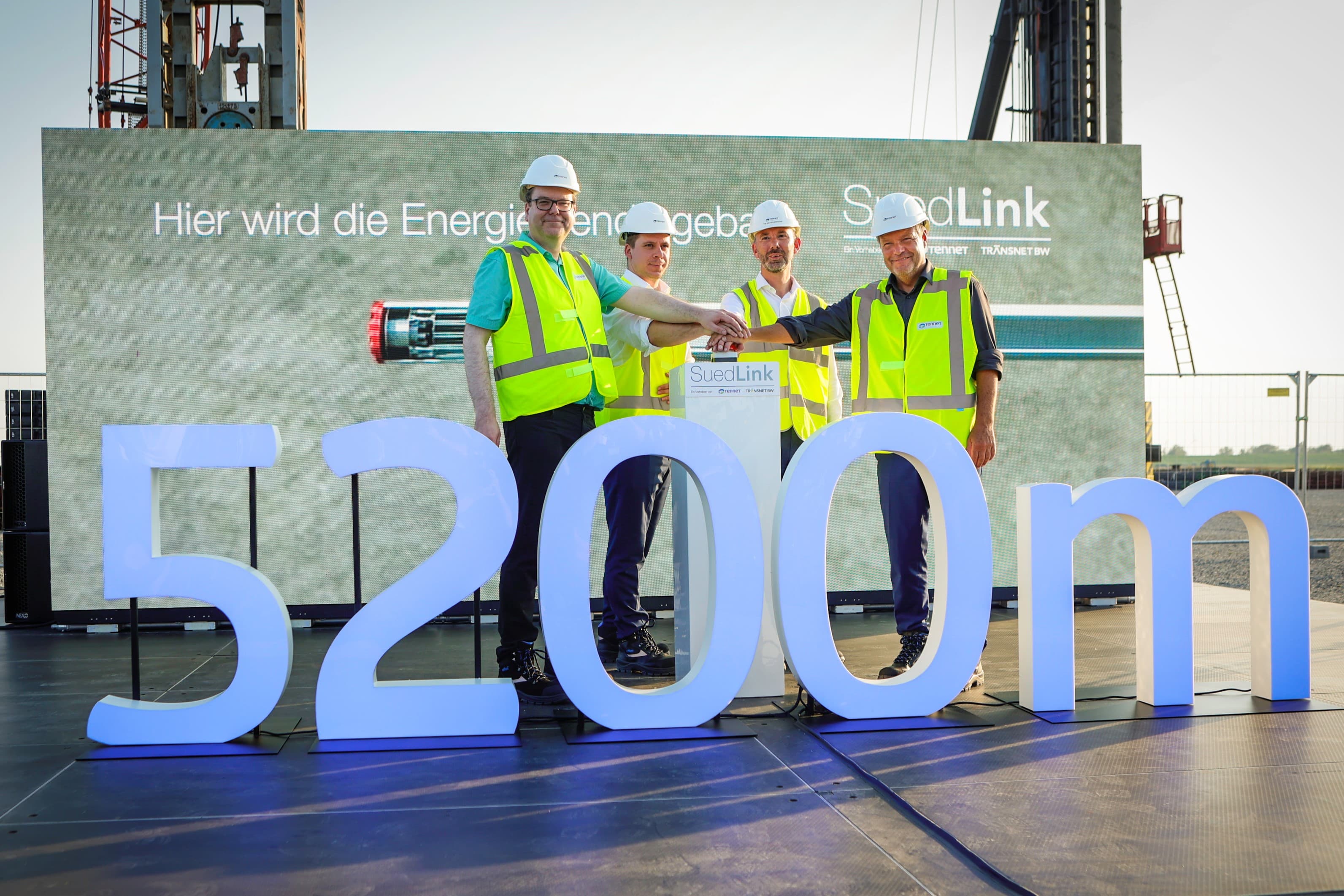
TenneT: The energy transition is becoming a reality – Construction of SuedLink has begun
Reading time
3 Minutes
Last updated
13/09/2023
Project
- TenneT celebrates start of SuedLink’s construction with federal and state politicians on the Elbe River
- The 5,200-metre power cables will cross the Elbe via a tunnel structure starting in Wewelsfleth
- Measures to prepare for the construction were already completed in Schleswig-Holstein in June 2023
After an extensive planning and approval phase, the construction of SuedLink is beginning in Northern Germany today. SuedLink did not receive the key building permit for the Elbe crossing area until mid-August. Nevertheless, thanks to an extremely efficient tender procedure as well as the swift and energetic mobilisation of the construction company, the building efforts will already officially commence on 11 September 2023. The starting signal has now been given in the north for what will be a key project in Germany’s energy transition.
At a ceremony held at the starting shaft of the Elbe crossing in Wewelsfleth, Schleswig-Holstein, the construction efforts were inaugurated by TenneT COO Tim Meyerjürgens, Federal Minister for Economic Affairs and Climate Action Dr Robert Habeck, Lower Saxony Energy Minister Christian Meyer and Schleswig-Holstein State Secretary for Energy Joschka Knuth. More than 100 guests joined them in celebrating this milestone.
“With the start of the Elbe crossing’s construction, SuedLink is becoming a reality,” TenneT COO Tim Meyerjürgens proudly noted. “As is shown by the fact that construction was started immediately after the permit was received, we can move fast. Now we will need to keep this pace up as these efforts proceed in order not to lose any time and to be able to enter into operation in 2028. To do so, we will need the continued cooperation and support of all stakeholders from politics, business and society. We will only be able to quickly advance the energy transition and thereby sustainably secure the German economy if we have the political and societal tailwind that we are feeling today on the West Coast and here at the SuedLink project.”
Today marks a decisive turning point for Lower Saxony Energy Minister Christian Meyer. “The north is paving the way for energy from renewable sources to be securely and efficiently supplied to all of Germany,” he said. “With the start of SuedLink’s construction here among us in the north, we are a decisive step closer to achieving our goals of climate neutrality and 100% energy provi-sion from renewable sources. Together with Schleswig-Holstein, Lower Saxony is a pioneer in the field of wind energy and has ambitious expansion targets both on land and at sea. In order to also get low-cost wind power to the south, we have already provided constructive support during the planning and approval process. With an Energy Transition Task Force specially formed to turbo-charge the construction and permitting efforts, we are supporting the grid expansion needed to achieve our climate targets.”
“The start of SuedLink’s construction represents a milestone for Germany’s energy transition,” said Schleswig-Holstein State Secretary for Energy Joschka Knuth. “The cables will be a game-changer for our energy supply and one of the most important axes in the climate-neutrality network of tomorrow. Climateprotection efforts and electricity customers will benefit in equal measure, as the cables will not only transport large amounts of green electricity, but also lower the curtailment quantities in the north.”
The start of construction of the Elbe crossing marks the beginning of what will be roughly four and a half years of construction work for SuedLink’s largest special structure. Via a tunnel structure of roughly five kilometres, the SuedLink cables will cross the Elbe in the stretch between Wewelsfleth in Schleswig-Holstein and Wischhafen in Lower Saxony. These efforts will employ the so-called “tunnel liner segment construction” method, in which a specially manufactured tunnel boring machine will dig its way under the Elbe like a mole. In a subsequent stage, six 525 kV power cables will be pulled through the tunnel and connected to the SuedLink underground cables on both sides of the Elbe. Even after the construction phase has been completed, rails in the tunnel will enable vehicles to access and move about the tunnel in order to perform maintenance and repair work.
TenneT already completed the measures to prepare for the construction efforts in Schleswig-Hol-stein in June 2023. Among other things, these measures included clearing the construction site, putting in place a medium-voltage power connection for the boring machine, and paving work.
Note to editors
You will find film and photo footage as well as additional information material in factsheets and brochures on SuedLink and this event under the following link (German only): https://www.tennet.eu/de/suedlink-bauauftakt
About SuedLink
With a length of around 700 kilometres and an investment of ten billion euros, SuedLink is a central infrastructure project of the energy transition in Germany. All sections of the project are currently in the planning approval process, in which the final route of the line will be determined.
TenneT is responsible for the northern section of SuedLink and the converters in Schleswig-Holstein and Bavaria. TransnetBW is responsible for the southern section of the line and the converter in Baden-Würt-temberg.
Contacts

